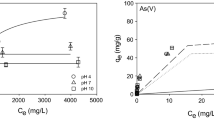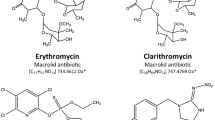Abstract
Dimethyldithioarsinic acid (DMDTAV), present in such intense sources as municipal landfill leachate, has drawn a great deal of attention due to its abundant occurrence and different aspect of toxicity. The hydrosulfide (HS−) concentration in leachate was studied as a major variable affecting the formation of DMDTAV. To this end, the HPLC–ICPMS system equipped with the reversed-phase C18 column was used to determine DMDTAV. Simulated landfill leachates (SLLs) were prepared to cover a mature landfill condition with the addition of sodium sulfate and sulfide at varying concentrations in the presence of dimethylarsinic acid (DMAV). The concentration of sodium sulfide added in the SLLs generally exhibited a strong positive correlation with the concentration of DMDTAV. As such, the formation of DMDTAV in the SLLs is demonstrated to be controlled by the interactive relationship between DMAV and the HS−.




Similar content being viewed by others
References
An, J., Kim, K.-H., Kim, J.-A., Jung, H., Yoon, H.-O., & Seo, J. (2013). A simplified analysis of dimethylarsinic acid by wavelength dispersive X-ray fluorescence spectrometry combined with a strong cation exchange disk. Journal of Hazardous Materials, 260, 24–31.
Bednar, A. J., Garbarino, J. R., Ranville, J. F., & Wildeman, T. R. (2002). Preserving the distribution of inorganic arsenic species in groundwater and acid mine drainage samples. Environmental Science and Technology, 36(10), 2213–2218.
Chen, Z., Akter, K. F., Rahuman, M. M., & Naidu, R. (2008). The separation of arsenic species in soils and plant tissues by anion-exchange chromatography with inductively coupled mass spectrometry using various mobile phases. Microchemical Journal, 89(1), 20–28.
Christensen, T. H., Kjeldsen, P., Bjerg, P. L., Jensen, D. L., Christensen, J. B., Baun, A., et al. (2001). Biogeochemistry of landfill leachate plumes. Applied Geochemistry, 16(7–8), 659–718.
Claret, F., Tournassat, C., Crouzet, C., Caucher, E. C., Schafer, T., Braibant, G., et al. (2011). Metal speciation in landfill leachates with a focus on the influence of organic matter. Waste Management, 31(9–10), 2036–2045.
Fricke, M. W., Creed, P. A., Parks, A. N., Shoemaker, J. A., Schwegel, C. A., & Creed, J. T. (2004). Extraction and detection of a new arsine sulfide containing arsenosugar in molluscs by IC-ICP-MS and IC-ESI-MS/MS. Journal of Analytical Atomic Spectrometry, 19, 1454–1459.
Fricke, M. W., Zeller, M., Sun, H., Lai, V. W. M., Cullen, W. R., Shoemaker, J. A., et al. (2005). Chromatographic separation and identification of products from the reaction of dimethylarsinic acid with hydrogen sulfide. Chemical Research in Toxicology, 18(12), 1821–1829.
Ghosh, A., Mukiibi, M., & Ela, W. (2004). TCLP underestimates leaching of arsenic from solid residuals under landfill conditions. Environmental Science and Technology, 38(17), 4677–4682.
Ghosh, A., Mukiibi, M., Sáez, A. E., & Ela, W. P. (2006). Leaching of arsenic from granular ferric hydroxide residuals under mature landfill conditions. Environmental Science and Technology, 40(19), 6070–6075.
Gong, Z., Lu, X., Ma, M., Watt, C., & Le, X. C. (2002). Arsenic speciation analysis. Talanta, 58(1), 77–96.
Grotti, M., Lagomarsino, C., Goessler, W., & Francesconi, K. A. (2000). Arsenic speciation in marine organisms from Antarctic coastal environments. Environmental Chemistry, 7, 207–214.
Guerine, T., Molenat, N., Astruc, A., & Pinel, R. (2000). Arsenic speciation in some environmental samples: a comparative study of HG–GC–QFAAS and HPLC–ICP–MS methods. Applied Organometallic Chemistry, 14(8), 401–410.
ISO 11885 (2007). Water quality—determination of selected elements by inductively coupled plasma optical emission spectrometry (ICP-OES). International Organization for Standardization (ISO).
Ito, A., Takachi, T., Kitada, K., Aizawa, J., & Umita, T. (2001). Characteristics of arsenic elution from sewage sludge. Applied Organometallic Chemistry, 15(4), 266–270.
Jain, C. K., & Ali, I. (2000). Arsenic: Occurrence, toxicity and speciation techniques. Water Research, 34(17), 4304–4312.
Khan, B. I., Jambeck, J., Solo-Gabriele, H. M., Townsend, T. G., & Cai, Y. (2006). Release of arsenic to the environment from CCA-treated wood. 2. Leaching and speciation during disposal. Environmental Science and Technology, 40(3), 994–999.
Komorowicz, I., & Baralkiewicz, D. (2011). Arsenic and its speciation in water samples by high performance liquid chromatography inductively coupled plasma mass spectrometry-last decade review. Talanta, 84(2), 247–261.
Li, Y., Low, G. K. C., Scott, J. A., & Amal, R. (2010). Arsenic speciation in municipal landfill leachate. Chemosphere, 79(8), 794–801.
Li, Y., Low, G. K. C., Scott, J. A., & Amal, R. (2011). Microbial transformation of arsenic species in municipal landfill leachate. Journal of Hazardous Materials, 188(1–3), 140–147.
Naranmandura, H., Carew, M. W., Xu, S., Lee, J., Leslie, E. M., Weinfeld, M., et al. (2011). Comparative toxicity of arsenic metabolites in human bladder cancer EJ-1 cells. Chemical Research in Toxicology, 24(9), 1586–1596.
Naranmandura, H., Ibata, K., & Suzuki, K. T. (2007). Toxicity of dimethylmonothioarsinic acid toward human epidermoid carcinoma A431 cells. Chemical Research in Toxicology, 20(8), 1120–1125.
Ochi, T., Kita, K., Suzuki, T., Rumpler, A., Goessler, W., & Francesconi, K. A. (2008). Cytotoxic, genotoxic and cell-cycle disruptive effects of thio-dimethylarsinate in cultured human cells and the role of glutathione. Toxicology and Applied Pharmacology, 228(1), 59–67.
Pereira, C. D., Garcia, E. E., Silva, F. V., & Nogueira, A. R. A. (2010). Behaviour of arsenic and selenium in an ICP-QMS with collision and reaction interface. Journal of Analytical Atomic Spectrometry, 25, 1763–1768.
Petrick, J. S., Ayala-Fierro, F., Cullen, W. R., Carter, D. E., & Aposhian, H. V. (2000). Monomethylarsonous acid (MMAIII) is more toxic than arsenite in Chang human hepatocytes. Toxicology and Applied Pharmacology, 163(2), 203–207.
Pinel-Raffaitin, P., Le Hecho, I., Amouroux, D., & Potin-Gautier, M. (2007). Distribution and fate of inorganic and organic arsenic species in landfill leachates and biogases. Environmental Science and Technology, 41(13), 4536–4541.
Ponthieu, M., Pinel-Raffaitin, P., Hecho, I. L., Mazeas, L., Amouroux, D., Donard, O. X. F., et al. (2007). Speciation analysis of arsenic in landfill leachate. Water Research, 41(14), 3177–3185.
Rader, K. J., Dombrowski, P. M., Farley, K. J., Mahony, J. D., & Di Toro, D. M. (2004). Effect of thioarsenite formation on arsenic(III) toxicity. Environmental Toxicology and Chemistry, 23(7), 1649–1654.
Raml, R., Goessler, W., & Francesconi, K. A. (2006). Improved chromatographic separation of thio-arsenic compounds by reversed-phase high performance liquid chromatography-inductively coupled plasma mass spectrometry. Journal of Chromatography A, 1128(1–2), 164–170.
Raml, R., Rumpler, A., Goessler, W., Vahter, M., Li, L., Ochi, T., et al. (2007). Thio-dimethylarsinate is a common metabolite in urine samples from arsenic-exposed women in Bangladesh. Toxicology and Applied Pharmacology, 222(3), 374–380.
Ritsema, R., Dukan, L., Navarro, T. R. I., van Leeuwen, W., Oliveira, N., Wolfs, P., et al. (1998). Speciation of arsenic compounds in urine by LC–ICP MS. Applied Organometallic Chemistry, 12(8–9), 591–599.
Sharma, V. K., & Sohn, M. (2009). Aquatic arsenic: Toxicity, speciation, transformations, and remediation. Environment International, 35(4), 743–759.
Suzuki, S., Arnold, L. L., Pennington, K. L., Chen, B., Naranmandura, H., Le, X. C., et al. (2010). Dietary administration of sodium arsenite to rats: Relations between dose and urinary concentrations of methylated and thio-metabolites and effects on the rat urinary bladder epithelium. Toxicology and Applied Pharmacology, 244(2), 99–105.
Suzuki, K. T., Mandal, B. K., Katagiri, A., Sakuma, Y., Kawakami, A., Ogra, Y., et al. (2004). Dimethylthioarsenicals as arsenic metabolites and their chemical preparations. Chemical Research in Toxicology, 17(7), 914–921.
Tu, C., Ma, L. Q., Zhang, W., Cai, Y., & Harris, W. G. (2003). Arsenic species and leachability in the fronds of the hyperaccumulator Chinese brake (Pteris Vittata L.). Environmental Pollution, 124(2), 223–230.
van de Wiel, H.J. (2004). Determination of elements by ICP-AES and ICP-MS. National Institute for Public Health and the Environment (RIVM), The Netherlands.
Wangkarn, S., & Pergantis, S. A. (2000). High-speed separation of arsenic compounds using narrow-bore high-performance liquid chromatography on-line with inductively coupled plasma mass spectrometry. Journal of Analytical Atomic Spectrometry, 15, 627–633.
Acknowledgments
This research was supported by a Grant from the Korea Basic Science Institute (Project No. T32603).
Author information
Authors and Affiliations
Corresponding author
Rights and permissions
About this article
Cite this article
An, J., Kim, KH., Kong, M. et al. Formation of dimethyldithioarsinic acid in a simulated landfill leachate in relation to hydrosulfide concentration. Environ Geochem Health 38, 255–263 (2016). https://doi.org/10.1007/s10653-015-9714-z
Received:
Accepted:
Published:
Issue Date:
DOI: https://doi.org/10.1007/s10653-015-9714-z




